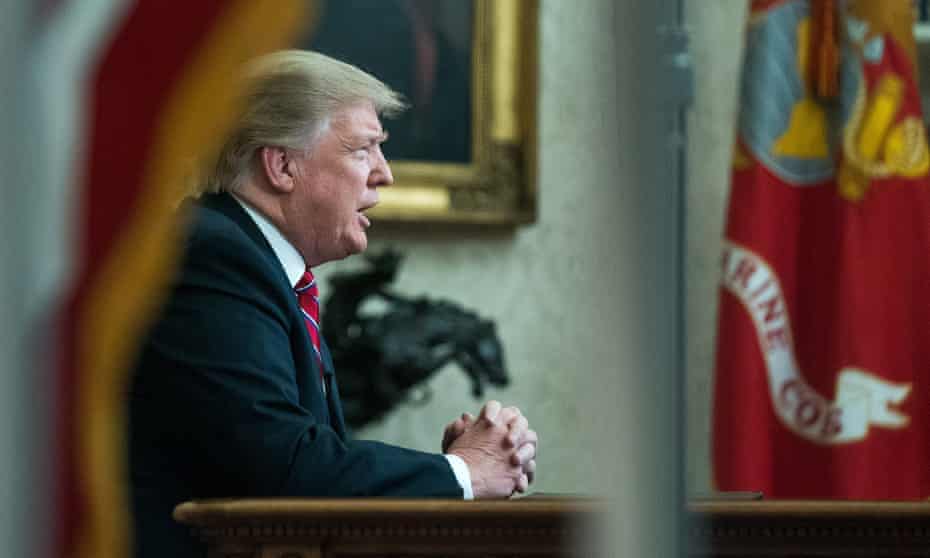Entertainment
Six key things to know about Trump’s border wall speech
The Things To Know About Trump’s Border Wall Speech
In a primetime address on Tuesday night, Donald Trump is expected to make a case for the US to expand its wall on the southern border.
(adsbygoogle = window.adsbygoogle || []).push({});
A fundraising email sent by the Trump 2020 campaign on Tuesday afternoon indicated that the president would probably offer the same arguments he has used since he was last on the election trail.
As the email had it: “Drugs are poisoning our loved ones. MS-13 gang members are threatening our safety. Illegal criminals are flooding our nation. I want to make one thing clear to Chuck Schumer and Nancy Pelosi: Your safety is not a political game or a negotiation tactic!”
Those arguments, however, tend to rely on inaccurate or dated statistics and lack important context about the situation at the border, which, as always, is complicated.
Here are six things you should know before the president’s address.
1. Terrorists rarely enter the US through Mexico
In September, a state department report concerning 2017 found “no credible evidence indicating that international terrorist groups have established bases in Mexico, worked with Mexican drug cartels, or sent operatives via Mexico into the United States. The US southern border remains vulnerable to potential terrorist transit, although terrorist groups likely seek other means of trying to enter the United States.”
A report released by the justice department in January 2018 linked immigrants to terrorism. But security analysts immediately said the report was misleading and this month the department acknowledged the report was rife with errors and deficiencies. It has, however, refused to retract or correct it.
Last week, the White House press secretary, Sarah Sanders, declared that 4,000 known or suspected terrorists had been apprehended at the southern border. Government officials soon appeared to walk back the claim.
(adsbygoogle = window.adsbygoogle || []).push({});
On Monday, the homeland security secretary, Kirstjen Nielsen, said the number of apprehended terrorists was classified, but 3,000 people who were from “special interest” countries and had unusual travel patterns, known as special interest aliens (SIA), were stopped at the border.
“I am sure all Americans would agree that one terrorist reaching our borders is one too many,” Nielsen said.
Analysts have pointed out that the SIA classification is given to any citizen of a non-western country who enters the US via the southern border.
2. A wall won’t stop drug traffickers
The US Drug Enforcement Agency (DEA) has said the most common way for traffickers to smuggle drugs across the border is by hiding them in cars that drive through official border checkpoints.
Nor would a wall resolve the demand for drugs. It just might make it more expensive for drug dealers to get drugs to customers in the US.
3. Illegal immigration to the US has plummeted
In 2000, the government apprehended 1.6 million people crossing the border illegally. Last year, it apprehended 310,531, the lowest figure since 1971. This number reflects a drop in illegal immigration that has held steady since the economic recession in 2008.
(adsbygoogle = window.adsbygoogle || []).push({});
4. People in the US illegally often enter legally
While 310,531 people were apprehended trying to cross the southern border illegally in 2017, in the same year more than 600,000 people who entered the US legally by air or sea overstayed their visas and remained in the country at the end of the year, according to the Department of Homeland Security (DHS).
This is a tiny fraction of the 52 million people who entered the US legally in 2017. It is estimated that the number of visa overstays are actually higher, because the DHS report does not include land crossings.
5. Unaccompanied children and families seeking asylum are approaching the border at overwhelming rates
In November, more than 25,000 families crossed the border, the highest monthly total on record. They are mostly from Central America and are fleeing violence and poverty.
The Trump administration shut down Obama-era programs that tried to address this problem and has implemented a metering policy at major ports of entry that limits how many people can seek asylum each day.
Shelters on both sides of the border are overwhelmed by asylum seekers and US Customs and Border Protection officers have been asking for more resources to house and process people.
People have a legal right to seek asylum but processing their claims is tough: the immigration court backlog has hit more than a million cases, according to Syracuse University’s transactional records access clearinghouse.
Trump consistently depicts the border crisis as an issue of national security, not a humanitarian matter. But on Sunday, in talks with Democrats aimed at ending the government shutdown, the White House added to its border wall funding proposal an offer of $800m to help fund care for families seeking asylum.
6. US citizens can also be dangerous criminals
The DHS said from October 2017 to August 2018, Customs and Border Protection encountered 16,831 “criminal aliens”. Of that group, 63% were stopped at at legal ports of entry, thanks to extensive security screenings.
That left 6,259 people who were apprehended and who had criminal convictions. Among that group, 47% were convicted for illegally entering or re-entering the US and 13% had records or convictions for sexual, violent or firearms offenses.
As PRI’s The World points out, a total of 362,000 people were apprehended by border patrol in the same period, which means one in 450 of them had such convictions. Among adult Americans, that ratio is one in 12 with felony convictions.
Source : TheGuardian
-

 Entertainment6 days ago
Entertainment6 days agoAdult Film Star Layla Red Cakes Shares Photos Of Her In Bed With Kai Cenat
-

 Sports6 days ago
Sports6 days agoVictor Wembanyama Says He Can’t Date American Women, Compares Them To NBA YoungBoy
-

 Sports7 days ago
Sports7 days agoKaka’s Ex Wife Reveals The Reason Why She Divorced Him Was Because He Was A Perfect Husband
-

 Entertainment2 days ago
Entertainment2 days agoDajshaDoll Drops Yung Miami Diss Track “Caresha Please”
-

 Entertainment7 days ago
Entertainment7 days agoBankroll Freddie Reportedly Beat All His Charges










You must be logged in to post a comment logged in Login